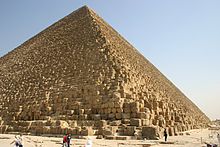This is an old revision of this page, as edited by 152.163.100.70 (talk) at 00:56, 17 October 2005. The present address (URL) is a permanent link to this revision, which may differ significantly from the current revision.
Revision as of 00:56, 17 October 2005 by 152.163.100.70 (talk)(diff) ← Previous revision | Latest revision (diff) | Newer revision → (diff) For other uses, see Khufu (disambiguation).
| |||||||||||||
| Khufu in hieroglyphs | |||||||||||||
|---|---|---|---|---|---|---|---|---|---|---|---|---|---|
| Era: Old Kingdom (2686–2181 BC) | |||||||||||||
Khufu (in Greek known as Cheops) was a Pharaoh of Ancient Egypt's Old Kingdom. He reigned from around 2589 BC to 2566 BC. He was the second pharaoh of the Fourth Dynasty.

Khufu was the son of King Sneferu and, unlike his father, was remembered as a cruel and ruthless pharaoh. Khufu had several sons, one of which, Djedefra, was his immediate successor. He had a daughter named Queen Hetepheres II.
Construction of the Great Pyramid

Khufu is most famous for being the alleged builder of the Great Pyramid of Giza, the only one of the Seven Wonders of the Ancient World still standing. Little else remains in his memory, and only one miniature statuette of him has been discovered in the temple of Abydos and is now on display in the Egyptian Museum, Cairo. His mummy has never been recovered. An empty sarcophagus is located in the King's Chamber inside the pyramid though it is unclear if it was ever used for such a purpose as burial.
There are two theories surrounding the construction of the Great Pyramid. The first theory, suggested by the Greeks, posits that slaves were forced to work until the pyramid was done. A more widely accepted theory in the modern era, however, suggests that the Great Pyramid of Egypt was built by hundreds of skilled workers who camped near the pyramids and worked for a salary or as a form of paying taxes until the construction was completed. Current consensus among Egyptologists also is that the head of the Great Sphinx at Giza is that of Khafre, who is believed to have built the pyramid next to Khufu's in the Three Great Pyramids of Giza.
In August 2004 two amateur French Egyptologists, Gilles Dormion and Jean-Yves Verd'hurt, claimed that they had discovered, using ground-penetrating radar and architectural analysis, a previously unknown corridor inside the pyramid. If their claim is true, the corridor is unlikely ever to have been violated and could possibly lead to a chamber containing the king's remains. But, as of yet, the pair have been refused permission by the Egyptian Supreme Council of Antiquities to follow up their findings and, they hope, prove the room's existence.
Some scholars believe that he was not a pharaoh, instead Khufu was a sign of the God of All Gods, or "the sun", so the Ancient Egyptians built the great pyramid in Giza to keep the worship to their god forever. However, since his full name is Chnum-Khufu, which means Chnum is protector, it seems as if he chose to use a theophoric name referring to a more supreme god Chnum, who protected him, so it is more likely that Khufu was simply human.
Categories: